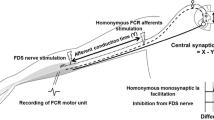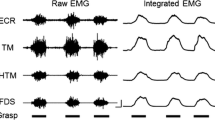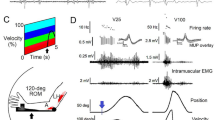Abstract
The present studies are designed to further characterise the interneuronal pathway mediating the disynaptic reciprocal group I inhibition between flexors and extensors at the wrist and the elbow levels in humans. In the first series of experiments, we compared the electrical threshold of the reciprocal group I inhibition at the wrist and the elbow level after a prolonged vibration aimed at raising the electrical threshold of the antagonistic activated Ia afferents. Prolonged vibration to the ‘conditioning’ tendon, which raised significantly the electrical threshold of the inhibition at the elbow level, did not alter it at the wrist level. These results suggest that the dominant input to the relevant interneurones is Ia in origin at the elbow level but Ib in origin at the wrist level. In the second series of experiments, using the spatial facilitation method, we compared the effects on the post-stimulus time histograms of single voluntarily activated motor units of two volleys delivered both separately and together to group I afferents in the nerves supplying the homonymous and antagonistic muscles. At the wrist, but not at the elbow level, the peak of homonymous monosynaptic group I excitation was reduced on combined stimulation, although the antagonistic IPSP was just at the threshold. Because the suppression did not involve the initial bins of the peak, it is argued that the suppression is not due to presynaptic inhibition of Ia terminals, but probably reflects convergence between the homonymous and antagonistic volleys onto the interneurones mediating the disynaptic inhibition. Taken together with the previously reported effects of recurrent inhibition on reciprocal inhibition, these results suggest that inhibition between flexors and extensors is differently organised at the elbow (reciprocal Ia inhibition) and the wrist (non-reciprocal group I inhibition) levels. It is argued that the particular connectivity at the wrist level might correspond to some functional requirements at this ball joint.







Similar content being viewed by others
References
Aymard C, Chia L, Katz R, Lafitte C, Pénicaud A (1995) Reciprocal inhibition between wrist flexors and extensors in man: a new set of interneurones? J Physiol 487:221–235
Aymard C, Decchi B, Katz R, Lafitte C, Pénicaud A, Raoul S, Rossi A (1997) Recurrent inhibition between motor nuclei innervating opposing wrist muscles in the human upper limb. J Physiol 499:267–282
Baldissera F, Campadelli P, Cavallari P (1983) Inhibition of H-reflex in wrist flexors by group I afferents in the radial nerve. Electroencephalogr Clin Neurophysiol 23:187–193
Baldissera F, Cavallari P, Fournier E, Pierrot-Deseilligny E, Shindo M (1987) Evidence for mutual inhibition of opposite Ia interneurones in the human upper limb. Exp Brain Res 66:106–114
Baret M, Katz R, Lamy JC, Pénicaud A, Wargon I (2003) Evidence for recurrent inhibition of reciprocal inhibition from soleus to tibialis anterior in man. Exp Brain Res 152:133–136
Berardelli A, Day BL, Marsden CD, Rothwell JC (1987) Evidence favouring presynaptic inhibition between antagonist muscle afferents in the human forearm. J Physiol 391:71–83
Burke D, Hagbarth KE, Löfstedt L, Wallin BG (1976) The responses of human muscle spindle endings to vibration of non-contracting muscles. J Physiol 261:673–693
Burke D, Hagbarth KE, Löfstedt L (1978) Muscle spindle activity in man during shortening and lengthening contractions. J Physiol 277:131–142
Burke D, Gandevia SC, McKeon B (1983) The afferent volleys responsible for spinal proprioceptive reflexes in man. J Physiol 339:535–552
Burke D, Gandevia SC, McKeon B (1984) Monosynaptic and oligosynaptic contributions to human ankle jerk and H-reflex. J Neurophysiol 52:435–448
Cavallari P, Katz R (1989) Pattern of projections of group I afferents from forearm muscles to motoneurones supplying biceps and triceps muscles in man. Exp Brain Res 78:465–478
Cavallari P, Fournier E, Katz R, Pierrot-Deseilligny E, Shindo M (1984) Changes in reciprocal Ia inhibition from wrist extensors to wrist flexors during voluntary movements in man. Exp Brain Res 56:574–576
Cavallari P, Katz R, Pénicaud A (1992) Pattern of projections of group I afferents from elbow muscles to motoneurones supplying wrist muscles in man. Exp Brain Res 91:311–319
Coppin CMC, Jack JJB, MacLennan CR (1970) A method for the selective electrical stimulation of tendon organ afferent fibres from the cat soleus muscle. J Physiol 210:18–20
Crone C, Nielsen J (1994) Central control of disynaptic reciprocal inhibition in humans. Acta Physiol Scand 152:351–363
Crone C, Hultborn H, Jespersen B, Nielsen J (1987) Reciprocal Ia inhibition between ankle flexors and extensors in man. J Physiol 389:163–185
Day BL, Rothwell JC, Marsden CD (1983) Transmission in the spinal Ia reciprocal inhibitory pathway preceding willed movements of the human wrist. Neurosci Lett 37:245–250
Day BL, Marsden CD, Obeso JA, Rothwell JC (1984) Reciprocal inhibition between the muscles of the human forearm. J Physiol 349:519–534
Downes L, Ashby P, Bugaresti J (1995) Reflex effects from Golgi tendon organ (Ib) afferents are unchanged after spinal cord lesion in humans. Neurol 45:1720–1724
Eccles JC (1964) The physiology of synapses. Springer Verlag, Berlin, pp 316
Fetz EE, Jankowska E, Johannisson T, Lipski J (1979) Autogenetic inhibition of motoneurones by impulses in group Ia muscle spindle afferents. J Physiol 293:173–195
Fournier E, Meunier S, Pierrot-Deseilligny E, Shindo M (1986) Evidence for interneuronally mediated Ia excitatory effects to human quadriceps motoneurones. J Physiol 377:143–169
Hammar I, Slawinska U, Jankowska E (2002) A comparison of postactivation depression of synaptic actions evoked by different afferents and at different locations in the feline spinal cord. Exp Brain Res 145:126–129
Harrison PJ, Jankowska E (1985) Source of input to interneurones mediating group I non-reciprocal inhibition of motoneurones in the cat. J Physiol 361:379–401
Heckman CJ, Condon MS, Hutton RS, Enoka RM (1984) Can Ib axons be selectively activated by electrical stimuli in human subjects? Exp Neurol 86:576–582
Hultborn H (1976) Transmission in the pathway of reciprocal Ia inhibition to motoneurones and its control during the tonic reflex. In: Homma S (ed) Progress in brain research. Understanding the stretch reflex, vol 44. Elsevier, Amsterdam, pp 235–255
Hultborn H, Jankowska E, Lindström S (1971) Recurrent inhibition of interneurones monosynaptically activated from group Ia afferents. J Physiol 215:613–636
Hultborn H, Meunier S, Morin C, Pierrot-Deseilligny E (1987). Assessing changes in presynaptic inhibition of Ia fibres: a study in man and the cat. J Physiol 389:729–756
Iles JF, Pisini JV (1992) Cortical modulation of transmission in spinal reflex pathways of man. J Physiol 455:425–446
Jankowska E (1992) Interneuronal relay in spinal pathways from proprioceptors. Prog Neurobiol 38:335–378
Jankowska E, Lundberg A (1981) Interneurones in the spinal cord. TINS 4:230–233
Katz R, Meunier S, Pierrot-Deseilligny E (1988) Changes in presynaptic inhibition of Ia fibres in man while standing. Brain 111:417–437
Katz R, Pénicaud A, Rossi A (1991) Reciprocal Ia inhibition between elbow flexors and extensors in the human. J Physiol 437:269–286
Lamy JC, Wargon I, Baret M, Ben Smail D, Milani P, Raoul S, Pénicaud A, Katz R (2005) Post-activation depression in various group I spinal pathways in humans. Exp Brain Res DOI 10.1007/s00221-005-2360-4
Livingston RB, Paillard J, Tournay A Fessard A (1951) Plasticité d’une synergie musculaire dans l’exécution d’un mouvement volontaire chez l’Homme. J Physiol 43:605–619
Lundberg A (1970) The excitatory control of the Ia inhibitory pathway. In: Andersen P, Janse JKS (eds) Excitatory synaptic mechanisms. Universitetforlaget, Oslo, pp 333–340
Lundberg A (1975) The control of spinal mechanisms from the brain. In: Tower DB (ed) The nervous system. The basic neuroscience, vol 1. Raven press, New York, pp 253–265
Meunier S, Pierrot-Deseilligny E (1998) Cortical control of presynaptic inhibition of Ia afferents in humans. Exp Brain Res 119:415–426
Morita H, Petersen N, Christensen LOD, Sinkjaer T, Nielsen J (1998) Sensitivity of H-reflexes and stretch reflexes to presynaptic inhibition in humans. J Neurophysiol 80:610–620
Nielsen J, Pierrot-Deseilligny E (1996) Evidence of facilitation of soleus-coupled Renshaw cells during voluntary co-contraction of antagonistic ankle muscles in man. J Physiol 493:603–611
Nielsen J, Sinkjær T, Toft E, Kagamihara Y (1994) Segmental reflexes and ankle joint stiffness during co-contraction of antagonistic ankle muscles in man. Exp Brain Res 102:350–358
Nielsen J, Crone C, Sinkjaer T, Toft E, Hultborn H (1995) Central control of reciprocal inhibition during fictive dorsiflexion in man. Exp Brain Res 104:99–106
Pauvert V, Pierrot-Deseilligny E, Rothwell JC (1998) Role of spinal premotoneurones in mediating corticospinal input to forearm motoneurones in man. J Physiol 508:301–312
Rossi A, Decchi B, Ginanneschi F (1999) Presynaptic excitability of group Ia fibres to muscle nociceptive stimulation in humans. Brain Res 818:12–22
Rothwell JC, Day BL, Berardelli A, Marsden CD (1984) Effect of motor cortex stimulation on spinal interneurones in intact man. Exp Brain Res 54:382–384
Schieppati M, Romano C, Gritti I (1990) Convergence of Ia fibres from synergistic and antagonistic muscles onto interneurones inhibitory to soleus in humans. J Physiol 431:365–377
Stephens JA, Usherwood TP, Garnett R (1976) Technique for studying synaptic connections of single motoneurones in man. Nature 263:343–344
Acknowledgements
The authors wish to express their gratitude to Professor E. Pierrot-Deseilligny for reading and commenting upon the manuscript. Our thanks are also due to M. Dodo for her unfailing assistance during the course of the experiments and G. Bard for typing the manuscript. This work was supported by grants from AP-HP, INSERM and MESR (unité de recherche mixte INSERM U731; UPMC) IRME and Institut Garches. Zaid Ghanim was supported by Ministère des Affaires Etrangères.
Author information
Authors and Affiliations
Corresponding author
Rights and permissions
About this article
Cite this article
Wargon, I., Lamy, J.C., Baret, M. et al. The disynaptic group I inhibition between wrist flexor and extensor muscles revisited in humans. Exp Brain Res 168, 203–217 (2006). https://doi.org/10.1007/s00221-005-0088-9
Received:
Accepted:
Published:
Issue Date:
DOI: https://doi.org/10.1007/s00221-005-0088-9




